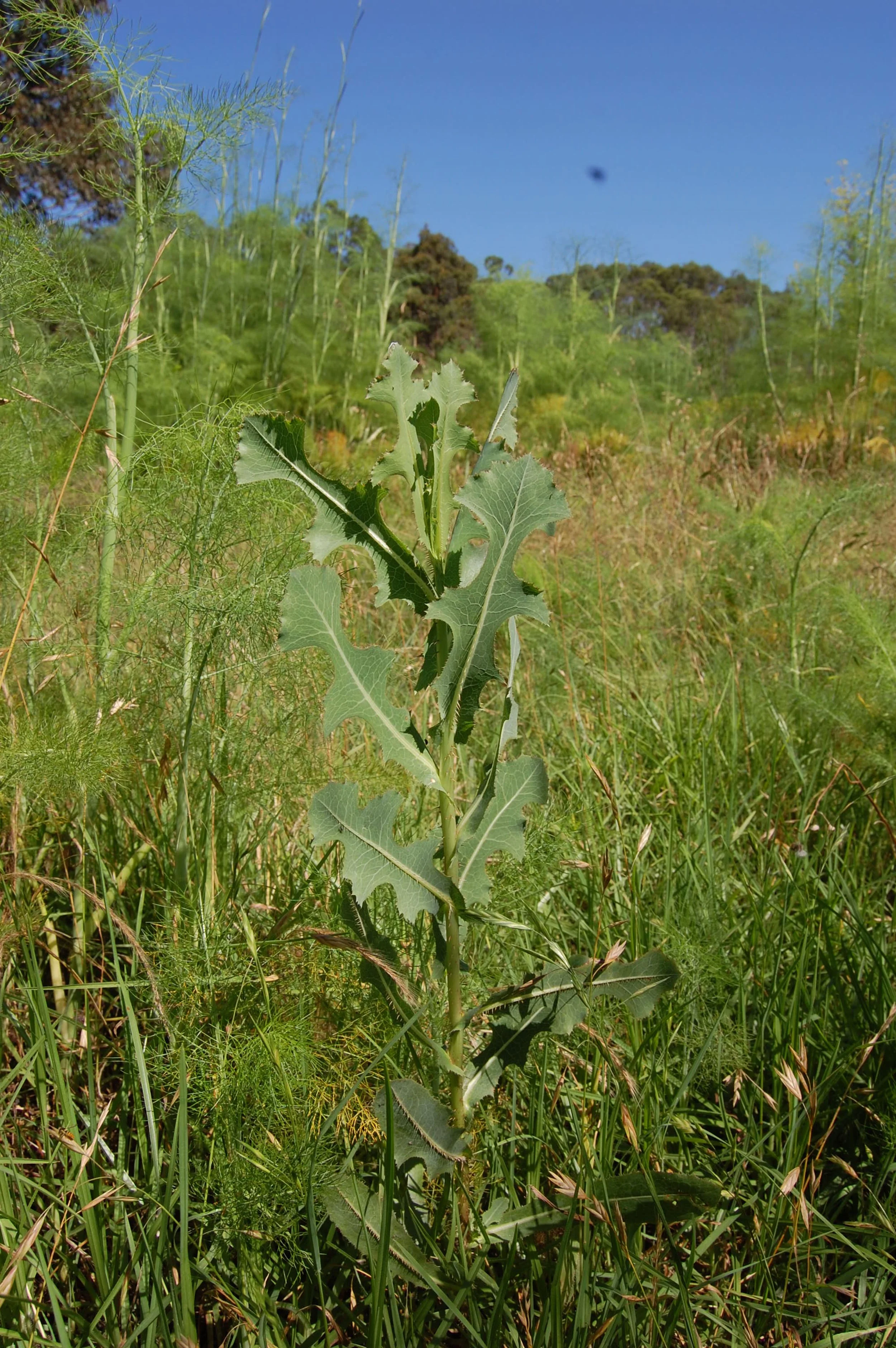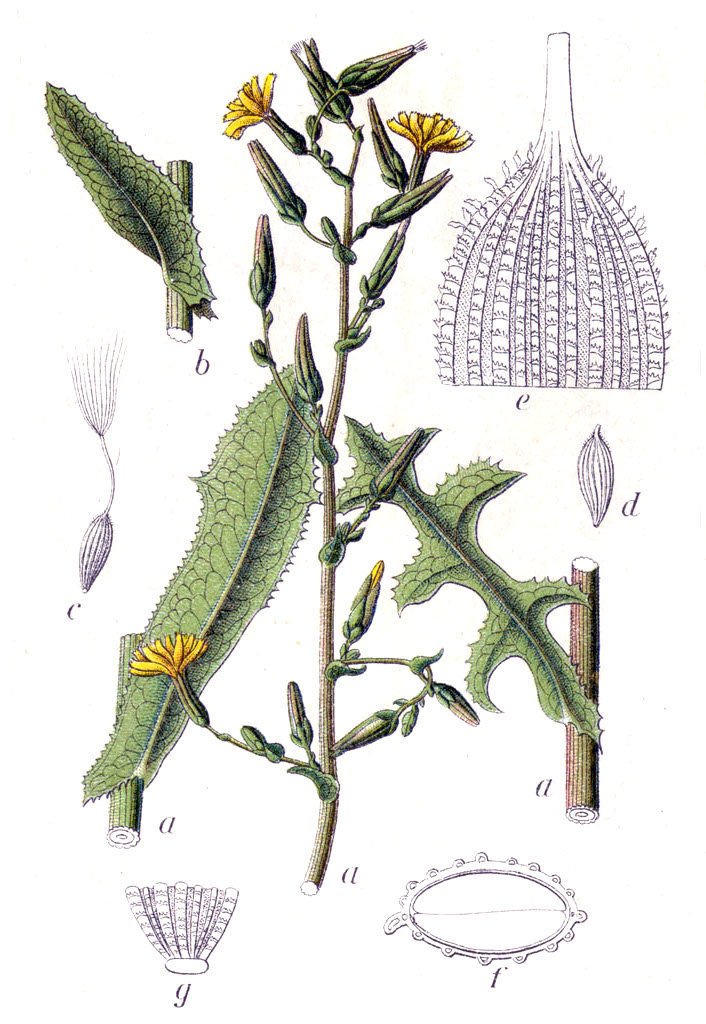Wild lettuce as food and pain relief: how to identify it in your garden.
Wild lettuce is regarded as the wild counterpart of the commercial lettuce you can buy at the supermarket. Although it is far more bitter than cultivated lettuce, it has greater nutritional and medicinal qualities. There are three varieties of wild lettuce in Australia, found in all states and territories: Prickly lettuce, Lactuca serriola, Opium lettuce, Lactuca virosa, and Willowleaf lettuce, Lactuca saligna.
Distribution
The maps below are from the government site Australian Virtual Herbarium which states that Lactuca virosa has only ever been found in Australia a couple of times.
I am now of the opinion that this is wrong as I have seen L. virosa growing wild in many places around Sydney, the South Coast, North Coast, and Central West of NSW. I can assume this is happening elsewhere as well.
Why it is not recorded on the government site I do not understand. Lack of information? Poor record-taking?
If anyone else has any opinion on this I would be grateful.
Identification
Wild lettuce is a biennial, fast-growing herb, reaching up to 2 metres in height. Any part of the plant will ooze a milky sap when cut.
Leaves and stalks The leaves at the base form a rosette and are larger (up to 25 centimetres long) than those growing up the flowering stalk. All leaves are oblong in shape and have prickles around the edges, as well as a distinctive line of prickles running up the spine on the underside of the leaf ( see image below). The leaves of younger plants are wider and less indented, transforming into deeply toothed as they grow older in prickly lettuce. Opium lettuce is substantially less ‘prickly’ than prickly lettuce, the leaves get much bigger and grow to 1.5-1.8 meters tall when in full flower. The leaves of willowleaf lettuce are substantially narrower than prickly lettuce and Opium lettuce ( see images below).
Flowers and seeds The flowering stem is stiff, tall and hollow and can grow to 1.8 metres in height. In prickly and opium lettuce, it branches out at the top with up to twenty flowers. While willowleaf lettuce flowers are produced mainly on the stalk, with minimal branching at the very tip. The flowers are small and yellow, 10–15 millimetres wide, and develop a puff of seeds when fertilised.
Prickly lettuce image- Lactuca serriola
Prickly lettuce in the fields. Note the lateral leaves growing form the stem.
Prickly lettuce- Growth habit. The plant grows both in isolation and in clusters.
Cluster of wild lettuce seedlings. Note the ‘rosette’ spread of the lower leaves when young.
Opium lettuce image+ video- Lactuca virosa
A good-looking specimen from my garden. When young wild lettuce has big and juicy leaves.
How to identify wild lettuce: note the line of hair on the back of the leaves.
Willowleaf lettuce images - Lactuca saligna
Lactuca saligna leaves. Note the flowers growing from the leaves
Lactuca saligna, willowleaf lettuce flowers- typical of the Chicoriaceae tribe of the Asteraceae
As food
I can only provide information for the prickly lettuce -L. serriola- and opium lettuce -L. virosa- as there is not much information about the edibility of willowleaf lettuce and I do not have personal experience to offer.
The best part of prickly lettuce - Lactuca serriola- is the young leaves. I love the strong, bitter taste, but if you are not accustomed to this flavour I’d suggest eating the leaves combined with other less intensely flavoured greens. Opium lettuce -Lactuca virosa- leaves can be eaten too when young but are even more bitter. It is a renowned ingredient in Greek folk recipes like hortapita (‘wild weeds’ pie). I usually cook it with other greens in pasta sauces or add it to soups. It is often abundant in my garden in early spring and it forms part of the mixed greens dishes that I serve at that time of the year. It is important to harvest the leaves when young as they progressively become less palatable. When young they are quite flavoursome.
**Please note that the sap of wild lettuce contains lactucarium, which is a mild narcotic. Lactucarium levels increase towards the time of flowering.
As medicine
The milky sap contains lactucarium, which has been used as medicine since antiquity for its digestive, diuretic, narcotic and sedative properties. Lactucarium is known as ‘poor man’s opium’ and can be taken internally as an infusion for the treatment of anxiety, hyperactivity, insomnia, coughs, rheumatic pain and more. We use this plant at home to make tea when we long for a good night’s sleep. It is mellow and effective. I always have some dry wild lettuce leaves in my dispensary, which I brew when needed. It is important not to boil the leaves, as very high heat will destroy the beneficial effects, so just place a few leaves in a teapot, add hot water and let it infuse for a few minutes.
Contentious information
There are several conflicting sources about the effects of wild lettuce as a pain killer, with several extraction techniques.
To date, there is no scientific consensus and scarce evidence and yet this plant has been used for medicinal purposes since antiquity. Many cultures around the world, particularly in the Middle East, use this plant regularly as folk medicine. I offer below a few links for further research. As for my experience, I regularly eat the young leaves when in season and used the tea for calming effects.
DISCLAIMER: This information should be used as a guide only. It is not my intention to advise anyone on medical conditions, rather I'm just presenting a new way to look at the plants growing in your yard.
Reference and further research
Plant for a future- An overview of the species
The Australian Virtual Herbarium - Distribution maps
Healthline - Review of wild lettuce pain relief
Drugs.com - Clinical overview of lettuce as narcotic
Practical self-reliance - An extensive overview of wild lettuce as pain relief folk remedy
Making lactarium - An excellent video from Sam of The Human Path
Wikipedia - There is always something to learn
Chicorieae portal - For the nerds













